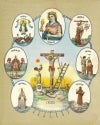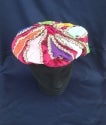Ochún Mazo
Initiation necklace for the oricha Ochun
Martin Tsang
Glass and plastic beads
Miami, FL, USA, 2017
L.2017.2.9
These magnificent necklaces are worn by new devotees during their
initiation. This one marks the wearer as a devotee of Ochún Ololodi, the
diviner Ochún. When not worn the mazo necklaces decorate home
altars.
Kélé Todos Orixás
Necklace for all the orixás
Glass beads
Rio de Janeiro, Brasil, 1991
L.2017.2.14
This necklace is a composite of symbols for fifteen orixás. Each is
indicated by color and pattern.
Ferramentas de Oxum [set of 4]
Set of tools for the orixá Oxúm
Afroarte Indústria
Brass and copper
Rio de Janeiro, Brasil, 1991
L.2017.2.1
These items form part of the regalia for the orixá Oxúm. They are worn
or carried by new initiates when they are first presented to the
community and when they incorporate the orixás in ritual dance.
Adé Oxúm
Initiation crown for the orixá Oxúm
Afroarte Indústria
Brass and copper
Rio de Janeiro, Brasil, 1991
L.2017.2.1.d
The crown (adé) indicates the regal status of the orixá and of her initiate
“crowned” with her powers.
Abébé Oxúm
Fan for the orixá Oxúm
Afroarte Indústria
Brass and copper
Rio de Janeiro, Brasil, 1991
L.2017.2.1.a
The fan recalls the cool breezes associated with the riverain orixá and her
status as an elegant lady.
Idá Oxúm
Sword for the orixá Oxúm
Afroarte Indústria
Brass and copper
Rio de Janeiro, Brasil, 1991
L.2017.2.1.b
The sword (idá) marks that the orixá fights for her children.
Adja Oxúm
Bell for the orixá Oxúm
Afroarte Indústria
Brass and copper
Rio de Janeiro, Brasil, 1991
L.2017.2.1.c
The bell (adja) is rung to call the orixá.
Adé Ochún with Tinaja
Altar crown for the oricha Ochún
Juan Gonzales (crown)
Brass crown with ceramic vessel
Miami, FL, USA, ca. 2000
L.2017.2.4
These crowns are placed atop vessels that hold the fundamental symbols
of the orishas, often stones and shells. This crown shows the color and
number of Ochún. The finial is her avatar, the Virgin of Charity.
Altar for Ochún
Altar for Ochún featuring statue of the Virgin of Charity. Vessels,
yellow flowers, honey, and beaded necklaces reference
Ochún. All is brilliant, golden, rich, and fecund.
Washington, DC, 2010
Photograph by Joseph M. Murphy
Adé Oya with Tinaja
Crown for the orisha Oya, mounted on blue vase
Antonio Salas (crown)
Copper crown with ceramic vessel
Miami, FL, USA, 2002
L.2017.2.35
As many of the orishas are royal figures their fundamental symbols – held
in porcelain vessels – are crowned with royal emblems. Here the orisha
Oyá is symbolized by red‐metal copper, nine tines, and nine miniature
“tools” showing her mastery of lightning, death, and the cemetery.
Adé Iemanjá Asésú
Initiation crown for the oricha Yemayá Asésú
Painted cardboard with applied fabric trims, plastic beads,
and shells
Miami, FL, USA, 2017
L.2017.2.29
This crown would be worn by new initiates into the devotion of Yemayá.
On the middle day of the initiation period, the new initiate is presented
to the community in the finery of his or her patron orisha.
Idá Yemayá
Knife for the oricha Yemayá
Glass beads, cowrie shells, wire, wood
Miami, FL, USA, ca. 2000
L.2017.2.3
The idá shows that the marine orisha fights for her children. It is beaded
in patterns of seven, in blue and clear, the colors of the ocean.
Adja Iemanjá
Bell for the orixá Iemanjá
Aluminum
Rio de Janeiro, Brasil, 1991
L.2017.2.5
The white‐metal bell is used to call the orixá before the home altar in
prayer and in ceremonial dance.
Abébé Yemayá
Fan/mirror for the oricha Iemanjá
White metal, aluminum
Rio de Janeiro, Brasil, 1990
L.2017.2.15
The abébé is a fan with a mirror set inside. Iemanjá is the orixá of the
seas. She is sometimes associated with the mermaid who gazes into the
mirror/water to perceive the other world.
Já Babalú Ayé
Whisk broom for the oricha Babalú Ayé
Palm fronds, beads, cowrie shells
Matanzas, Cuba, 2001
L.2017.2.8
The ja (pronounced like “hah”) is a stylized broom carried by the orisha
of disease in dance and used to admonish the congregation and sweep
away disease and misfortune.
Irukere Obatalá
Royal fly whisk for the oricha Obatalá
Artesania Yoruba
Wood, glass beads, horsehair
Hialeah, FL, USA, 2011
L.2017.2.19
The fly‐whisk is a symbol of royalty throughout much of Africa. This
irukere of white horsetail and white‐beaded handle is for Obatalá the
pre‐eminent kingly orisha in the Yoruba pantheon
Adé Yemayá with Tinaja Olokun
Altar crown for the oricha Yemayá, with vessel for
the oricha Olokun
Antonio Salas (crown)
Aluminum crown with ceramic vessel
Miami, FL, USA, 2005
L.2017.2.6
These crowns are placed atop vessels that hold the fundamental symbols
of the orishas, often stones and shells. This crown shows the color and
number of Yemayá, armed with tools for the defense and cultivation of
the devotee.
Opón Ifá
Tray to hold divination tools
Wood
Nigeria, ca. 1940
L.2017.2.11
This tray is a fine example of Yoruba ritual arts. Similar ones are carved in
Cuba. The surface is spread with sacred palm‐wood dust and the diviner
makes marks on it for the appropriate divinatory signs. The face is that of
Eshu, the unreliable mediator.
Royal Procession in Benin
Naukeurige Beschrijvinge der Afrikaensche Gewesten van Egypten,
Barbaryen, Libyen, Biledulgerid, Negroslant, Guinea, Ethiopiën, Abyssinie…
Olfert Dapper
Amsterdam: Jacob van Meurs, 1668
Booth Family Center Rare Books Collections
97B35
Las Siete Potencias Africanas
Commercial/offset printing on paper
Mexico, before 1975
L.2017.2.31
At least as early as the mid‐nineteenth century, enslaved and free Yoruba
in Cuba were associating their orishas with Catholic saints. In this
provocative and informative lithograph the santos are shown with their
Yoruba names. Clockwise from lower left:
Obatala – Nuestra Señora de las Mercedes – Our Lady of Ransom
Yemalla – Nuestra Señora de Regla – Our Lady of the (Franciscan) Rule
Ochun – Nuestra Señora de la Caridad – Our Lady of Charity of Cobre
Chango – Santa Barbara
Orula – San Francesco d'Assisi
Ogun – San Juan Bautista
Elegua – San Benito el Moro
Olofia – Jesus
Santa Barbara Caballero
Painted plaster
Arlington, VA, USA, 2017
L.2017.2.27
Here Santa Barbara, the ancient martyr, is imaged as a mounted warrior
like the Yoruba warrior king Changó. The composition is a fine example
of the blend of African and Catholic elements in devotees’ spiritual lives.
Caldero and Adé Ogun
Cauldron and crown of the orisha Ogun
Oggun Bemi
Cauldron: iron; crown: white metal
Oakland, CA, USA, 2009
L.2017.2.23
As the orisha of the forge Ogún is imaged by the iron cauldron and tools.
As a royal orisha Ogún wears an iron crown. This creative crown by artist
Oggun Bemi has the forge’s anvil for its finial and symbols of power hang
from the band.
El Niño de Atocha
Painted plaster
Mexico, 2014
L.2017.2.25
The Niño is a Spanish devotion to the Christ child who aided imprisoned
Christian soldiers during the reconquest of Iberia. Yoruba Christians saw
in the Niño parallels to Eleggua who is often imaged as a child who can
cross boundaries.
Ibéjì with Idòwú
Painted plaster
Rio de Janeiro, Brasil, 1991
L.2017.2.30
In Yorubaland twins are thought to possess supernatural powers and the
ibéjì are twin spirits who bring wealth and good fortune to their parents.
The child born after the twins (ìdòwú) is said to possess the powers of
the twins concentrated in one person. Here the Catholic twin saints,
Cosmas and Damian, are shown with their ìdòwú.
Osun Babalú Ayé
Altarpieces for Babalú Ayé
Tin
Miami, FL, USA, 2010
L.2017.2.10
The osun is a miniature staff of authority of the orisha. Because of Babalú
Ayé’s strong association with the poor man Lazarus of the gospel he is
symbolized by the crutches of the poor man and his canine companions.
San Lázaro/Babalú Ayé
Figurine with features of both San Lázaro and
Babalú Ayé
Painted resin figurine made in China, with polyester cape
handmade in Miami
Hialeah, FL, USA, 2016
L.2017.2.18
San Lazarus is a devotion arising out of a parable told by Jesus in Luke 16.
His is imaged as a sick man with crutches and accompanied by dogs.
Many devotees correspond him to Babalú Ayé, the orisha who brings
disease and cures it.
Gorro Oyá
Cap for the orisha Oyá
Cloth with applied trim
1992
L.2017.2.37
When ritual work is undertaken, devotees will often wear brimless caps
such as this, sometimes decorated with the colors of the orisha being
venerated or those of their patron orisha. The 9 colors on a maroon
background signal a cap for Oyá, the “mother of nine."
Eleggua
Figurine depicting Eleggua
Concrete, cowrie shells, iron nail
Arlington, VA, USA, 2017
L.2017.2.24
Eleggua is the orisha of openings, beginnings, and liminal spaces. Once
consecrated busts like this are placed at the doorways of devotees to
protect the premises and discomfit unwanted intruders.
Garabato Eleggua
Hook for the oricha Eleggua
Glass beads, cowrie shells, wire, wood
Miami, FL, USA, ca. 2000
L.2017.2.2
The garabato is a stylized hook used by Eleggua to clear paths of
vegetation. In dance Eleggua will brandish the garabato and sometimes
use it to trip unsuspecting onlookers.
Oché Changó
Axe for the oricha Changó
Alberto Druyat
Acrylic paint on wood
Matanzas, Cuba, ca. 2005
L.2017.2.33
The double‐headed axe is the preeminent symbol of Changó the orisha of royalty, thunder, and lightning. This bright piece would adorn one of Changó’s elegant altars and might be taken up by one of his mediums and carried like a powerful wand in ceremonial dance.
Oxé Xangó
Copper double‐headed axe for the orixá Xangó
Copper
Salvador da Bahia, Brasil, 1991
L.2017.2.34
In Brazil as in Cuba the double‐headed axe is the premier symbol of the
orisha of royalty, thunder, and lightning. As a “red metal” this copper
oxé highlights Xangó’s embodiment of fire and hot energy.
Oché Changó
Axe for the oricha Changó
Baba Ade Cola
Glass beads, cowrie shells, wood
Los Angeles, CA, USA, 2010
L.2017.2.7
The double‐headed ax shows Changó’s power, splitting the sky with thunder. The red and white beads in patterns of six recall jagged lightning bolts.
Santera Changó
Changó priestess Barbarita De Leon holds an oché
in a traditional gesture.
Matanzas, Cuba, 2001
Photograph by Joseph M. Murphy
Beaded Drape for Changó Altar
Beaded drape for altar of the oricha Changó
Glass beads
Gaithersburg, MD, USA, 2011
L.2017.2.28
This ará drapes over the sacred vessel (batea) of the orisha Changó. The
six tools show his array of powers to work for his devotees.
Batea and Pilón Changó
Vessel and pedestal for the orixá Changó
Acrylic paint on wood
Miami, FL, USA, 2016
L.2017.2.12
The pedestal (pilón) represents Changó’s throne while the bowl (batea)
contains his essential symbolic objects (fundamentos). The decorations
depict Chango’s tools, notably his oshé, the double‐headed axe.
Guest Curator: Joseph M. Murphy, the Paul and Chandler Tagliabue Distinguished Professor of Interfaith Studies and Dialogue
Liason from the Booth Family Center for Special Collections: Christen E. Runge, Assistant Curator, Art Collection
With assistance from Special Collections Intern Charles T. Cooper (C'18)

































